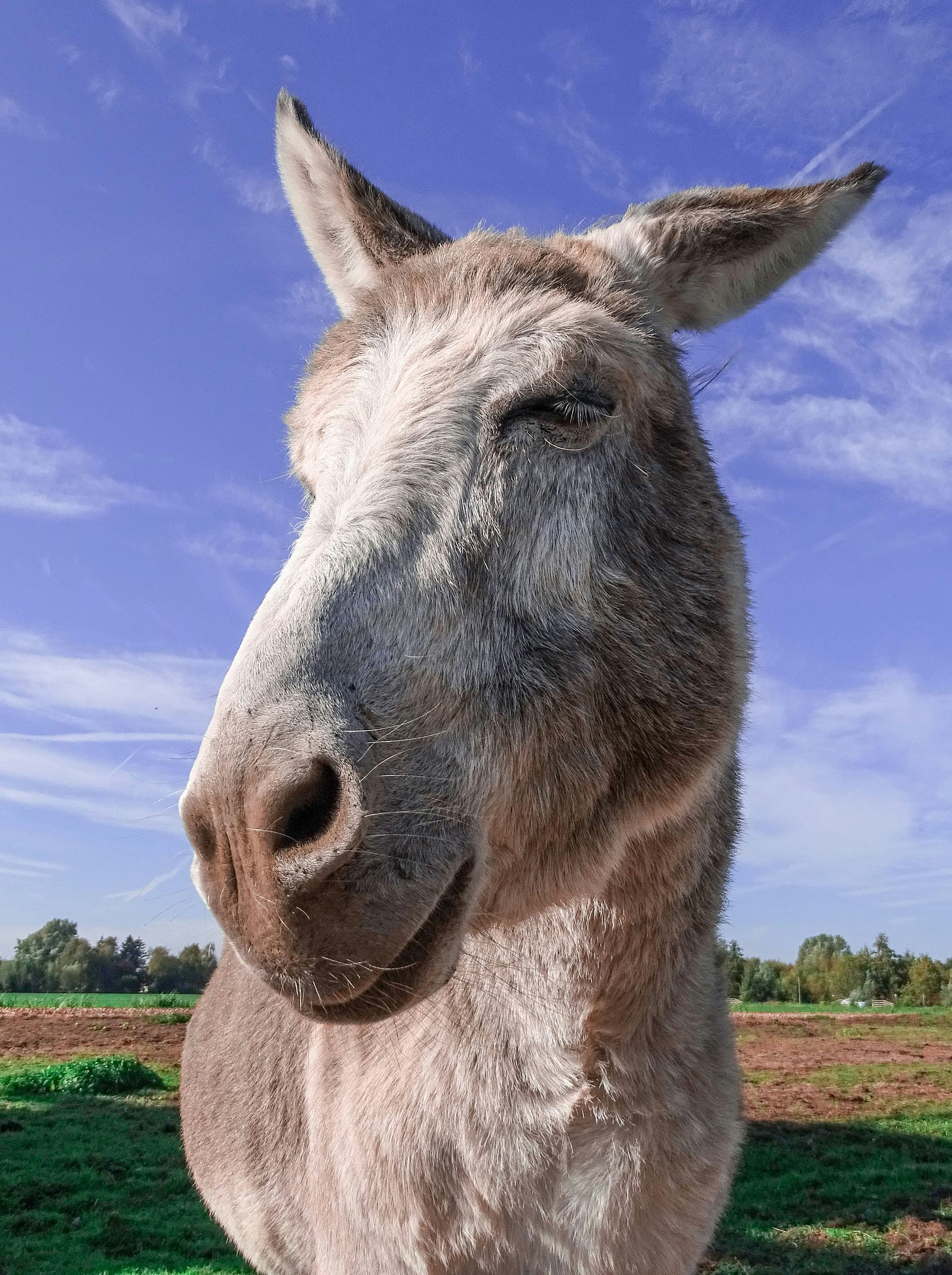Home of Eisenhower the Donkey
How an old farm sign in a construction zone changed my perspective on food and land.
Three times a week for seven years, I drove past the weathered white sign, WHITE OAK FARMS: HOME OF EISENHOWER THE DONKEY.
But I never actually saw a donkey.
Still, it touched me. I would glance at the sign and then at the field, thinking that maybe this week the Methuselah of donkeys would hobble across the unkempt orchard grass with his bristle brush mane and oversized teeth.
Then I noticed the orange flags. For a quarter of a mile, the orange flags marched across the ground or wrapped the formidable girths of trees that had once watched pioneers roll down the dirt road in horses and wagons (I know I am anthropomorphizing here, bear with me).
Next, they removed the fence posts. Then the pile of culverts arrived, each so large that my nine-year-old daughter could have easily stood inside.
Three times a week, I watched the steady progress. Beeping backhoes and dump trucks. Men wearing hardhats and reflective lime green vests and waving clipboards around.
Three times a week, I watched the virgin acreage being peeled back to reveal the wound of red clay earth.
And yet Eisenhower the donkey’s sign remained.
On Friday, I was so intently searching for the sign that the traffic guard waved her STOP sign at me and frowned. I looked at her and she mouthed Thank you (at least I think she said thank you). A dump trunk rolled out onto the road and passed on my left, and then she flipped her sign to SLOW.
Navigating the corridor of orange construction cones, I knew that within a matter of hours or days that sign would be gone, and I felt a disproportionate sense of loss.
My best friend and I talked on the phone a few days after I learned of her diagnosis. Our conversation was stilted. I was angry, not at her by any stretch, but by the fact that she had fought cancer twice in her forty-one years and now she was having to fight it again.
At one point, walking by my neighbor’s field of lazy beef cattle, I tossed all the careful phrases and said, “Honestly, I just want to rip out one of these fence posts and beat it against the ground!”
We both laughed. And then, because my anger was not helpful and neither were my questions, I told her about Eisenhower the donkey.
I told her about the beehives that used to be across the road from the sign. A few years ago, bulldozers flattened the hives and an abandoned brick house. Concrete unspooled like an unforgiving black carpet and then cranes constructed a behemoth of a Food City with fluttering red and blue streamers and a Starbucks kiosk by the stainless-steel salad bar and, in the parking lot, a Dunkin’ Donuts for those who believe Starbucks burns their beans.
My best friend, four years older, has always been supportive of my stories, especially when I am telling them because we don’t want to hang up but neither do we want to discuss cancer.
She said, “It reminds me of the donkey who tried to warn Balaam about the angel, but he just kept beating him because he could not see the angel for himself.”
What if that weathered sign about Eisenhower the donkey is warning us, and yet we keep on bulldozing around it because we cannot see what’s ahead?
I recently read a post by my favorite modern composer who was discussing the impact of Artificial Intelligence on his profession. He said that one day, if we are not careful, people will marvel at previous symphonies. All those musicians who had labored to learn their wood and string instruments, who could work together in harmony to produce glorious sound!
I dare say the same is true of farming. We, as a culture, are losing our ability to provide food for ourselves. We pull up in a parking lot, push a button on our phones, a man appears with our bags, and loads them in our vehicles. Then we roll home (past the beeping bulldozers and dump trucks flattening more land) and fill our fridges with a week’s supply of food, fully expecting that that food will be there when we need more.
(I say this while admitting Instacart has recently improved my quality of life.)
But what if, one day, that food is gone?
What if, when every acre is covered with concrete, we marvel at our forebears’ ability to conjure forth food just as users of AI will marvel watching old string symphonies when there’s no one left who can produce sound?
This isn’t just about Eisenhower the donkey, or a sign that will soon be destroyed when the concrete trucks arrive. It is about knowing the value of the land around us, and the harmony of life that can be conjured from the ground with a few tools and some well-placed seeds.
Gardening season is upon us. Let’s go forth and learn while there’s still time.






A couple counties over from us is a large strip of untouched land, gold and green and lush with ravines and streams. DC's suburban sprawl has shoved up against the edges of it for decades, an oasis of nature surrounded by traffic. The reason it remains untouched? It's a massive vein of asbestos.
I was intrigued by the sign, and after a few minutes of digging on the internet, I found this gem dated 2013 that gives you a little history on what Eisenhower used to do: https://www.uglyhedgehog.com/t-173350-1.html: "Oreo cows! at least the black/white ones! We have some in our area. One group of them is being guarded by Eisenhower, the donkey. I know that because the owners erected a huge sign attesting to that fact!"